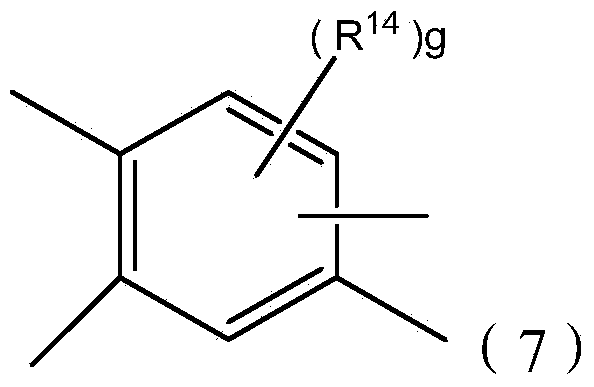Resin composition for lithium ion cell positive electrode
A technology of lithium ion battery and resin composition, applied in the direction of lithium storage battery, battery electrode, battery, etc., can solve the problems of reduced electrolyte injection, prone to cracks, reduced input and output characteristics, etc., and achieves good charge-discharge characteristics. Effect
- Summary
- Abstract
- Description
- Claims
- Application Information
AI Technical Summary
Problems solved by technology
Method used
Image
Examples
Embodiment
[0094] In order to describe the present invention in more detail, examples are given below, but the present invention is not limited by these examples. In addition, each characteristic of an Example was evaluated by the following method.
[0095] (1) Linear thermal expansion coefficient
[0096] Each of the varnishes obtained in Synthesis Examples 1 to 20 was coated on a 4-inch silicon wafer, and pre-dried at 100° C. for 3 minutes on a hot plate. Next, the wafer with the film was heat-treated at 350° C. for 1 hour in an oven (INH-9: manufactured by KOYO THERMO SYSTEMS CO., LTD.) whose oxygen concentration was controlled to be 50 ppm or less. The coating conditions at this time were set so that the film thickness after the heat treatment would be 10 μm±1 μm.
[0097] Next, it was immersed in 45% hydrofluoric acid aqueous solution at room temperature for 10 minutes, washed with water, and the polyimide film was peeled off from the wafer. The peeled film was dried at 120° C. fo...
Synthetic example 1
[0132] Under a nitrogen atmosphere, 26.02 g (0.05 mol) of BSAA, 9.9 g (0.05 mol) of RIKACID BT-100, and 100 g of NMP were added to the four-necked flask, and stirred at 40° C. for 30 minutes. 2.18g (0.02mol) of MAP and 13.18g of NMP were added thereto, and it stirred at 60 degreeC for 1 hour. 32.96 g (0.09 mol) of 6FAP and 100 g of NMP were added after 1 hour, and it stirred at 60 degreeC for 1 hour, and then stirred at 200 degreeC for 6 hours. After cooling to room temperature for 6 hours, NMP was added to finally obtain a polyimide solution with a solid content concentration of 20%. Let this be Varnish A.
Synthetic example 2
[0134] Under a nitrogen atmosphere, 18.61 g (0.06 mol) of ODPA, 12 g (0.04 mol) of RIKACID TDA-100, and 137.25 g of NMP were added to a four-necked flask, and stirred at 40° C. for 30 minutes. 2.18 g (0.02 mol) of MAP and 10 g of NMP were added thereto, and stirred at 60° C. for 1 hour. 32.96 g (0.09 mol) of 6FAP and 50 g of NMP were added after 1 hour, and it stirred at 60 degreeC for 1 hour, and then stirred at 200 degreeC for 6 hours. After cooling to room temperature after 6 hours, the solution was poured into 3 L of pure water to precipitate a polymer, and the precipitate was separated by filtration. This sorted product was added to 3 L of pure water and filtered and sorted five more times, and then dried in an oven at 80° C. for 5 days under a nitrogen atmosphere.
[0135] After adding 80 g of NMP to 20 g of the dried powder to dissolve it, the solution was filtered with a 10 μm membrane filter to finally obtain a polyimide solution with a solid content concentration of...
PUM
 Login to View More
Login to View More Abstract
Description
Claims
Application Information
 Login to View More
Login to View More - R&D
- Intellectual Property
- Life Sciences
- Materials
- Tech Scout
- Unparalleled Data Quality
- Higher Quality Content
- 60% Fewer Hallucinations
Browse by: Latest US Patents, China's latest patents, Technical Efficacy Thesaurus, Application Domain, Technology Topic, Popular Technical Reports.
© 2025 PatSnap. All rights reserved.Legal|Privacy policy|Modern Slavery Act Transparency Statement|Sitemap|About US| Contact US: help@patsnap.com



